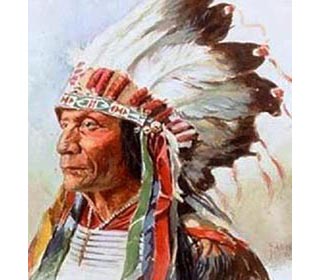Every one of the feathers in the war bonnet headdress was a symbolic reflection of the brave deeds and battles that the warrior had been engaged in. The war bonnet was a symbol of high respect and a visible display of a warrior's bravery, honor and standing in his tribe. War Bonnet Fact Sheet - War Bonnet Fact 1: The warriors of Native American Indian tribes wore a variety of different styles of warbonnets. These symbolic headdresses included Buffalo Horn Headdresses, Halo Warbonnets, Straight-up Feathered Warbonnets, the crown and plume warbonnets and the famous long trailing feathered war bonnet
- War Bonnet Fact 2: The famous long, trailing feather war bonnets were worn by tribes such as the the Sioux and the Cheyenne
- War Bonnet Fact 3: The Buffalo Horn war bonnets, was worn by the Sioux and the Chippewa (Ojibwe) tribes, consisted of a buffalo hide skullcap with either long or short tails, with feathers attached, hanging from the back. The horns were polished and sometimes painted with symbolic colors and symbols. Only the bravest of warriors were given permission to wear the horned warbonnets
- War Bonnet Fact 4: The 'Straight-up' Feathered War bonnet which was taller and narrower than other headdresses with the feathers going straight up and worn by the Kiowa, Blackfoot and the Comanche tribes
- War Bonnet Fact 5: The Halo war bonnet had feathers fanning out to the back
- War Bonnet Fact 6: Feather crown and plume war bonnet was worn by tribes in California such as the Shasta and Chumash
- War Bonnet Fact 7: A Native Indian warrior earned a feather for each courageous act he accomplished
- War Bonnet Fact 8: The chief of every tribe had a special war bonnet. The feathers on the Chief's headdress were given to him due to the contributions he had made to the tribal community and a mark of great honor. The chief’s headdress consisted of many many feathers, each feather representing a good deed, which is why the long trailing warbonnets were often worn and associated with the Chief of a tribe
- War Bonnet Fact 9: Every feather in warbonnet headdress was awarded by the tribal elders for some great deed, usually in warfare. This practise lead to the expression "a feather in his cap"
- War Bonnet Fact 10: The feathers were decorated in different styles, colors and designs that would signify why the feather was awarded to the person
- War Bonnet Fact 11: Each time a warrior earned a feather, he would either wear it or displayed it on a pole used for ceremonial occasions and rituals. Once a warrior had collected enough feathers, they were then made into a headdress.
- War Bonnet Fact 12: Only the men of the tribe, usually the closest friends of the warrior, were involved in making the war bonnet headdress
- War Bonnet Fact 13: The most prized of all feathers was the Golden Eagle feather. The eagle was considered a messenger from the Great Spirit
- War Bonnet Fact 14: It is believed that the idea of wearing a warbonnet originated with the Sioux people
- War Bonnet Fact 15: There were different ways of earning the privilege and honor of being able to wear a warbonnet. A warrior who was the first to touch a fallen enemy in a battle could earn the privilege as this signified that the warrior was at the forefront of the fighting
- War Bonnet Fact 16: Meaning of bird feathers: Eagle feathers indicated great strength and courage, Crow feathers indicated skill and cunning, Falcon feathers represented speed, Hawk feathers indicated strength and vision, Hummingbird feathers represented intelligence, Owl feathers (wisdom) and Raven feathers ( knowledge)
|
